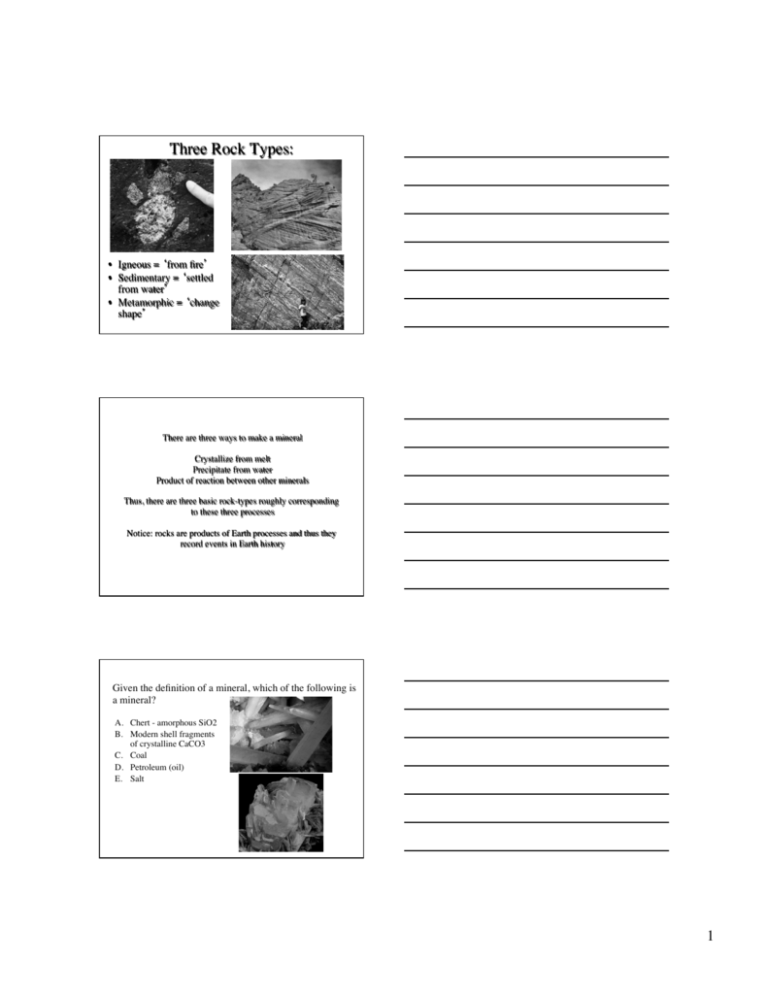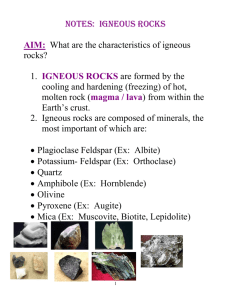Three Rock Types:
advertisement

Three Rock Types: • Igneous = ‘from fire’ • Sedimentary = ‘settled from water’ • Metamorphic = ‘change shape’ There are three ways to make a mineral Crystallize from melt Precipitate from water Product of reaction between other minerals Thus, there are three basic rock-types roughly corresponding to these three processes Notice: rocks are products of Earth processes and thus they record events in Earth history Given the definition of a mineral, which of the following is a mineral? A. Chert - amorphous SiO2 B. Modern shell fragments of crystalline CaCO3 C. Coal D. Petroleum (oil) E. Salt 1 Rock Cycle • Earth processes ‘transfer’ rocks from one type to another – Erosion – Burial – Melting • More later... Let’s begin with igneous rocks. These are rocks formed from minerals that crystallize from a melt. Where does melting occur? Each setting represents a different melting process... Two ways to melt the asthenosphere • Decompressive melting – Asthenosphere rises faster than it looses heat • as seafloor spreading thins lithosphere, or • in a rising hotspot – Hot shallow asthenosphere crosses the melting curve (solidus) – These melts rise through the lithosphere to erupt at Mid-ocean ridges or hot-spot volcanoes • Hydration (or Flux) Melting – Volatile fluids are boiled and squeezed from the subducting lithosphere – Addition of fluids to the asthenosphere lowers the melting temperature of the asthenosphere below the ambient temperature (‘Solidus with water’ is lower than the ‘geotherm’) – These melts rise through the lithosphere and erupt as subduction zone volcanoes 2 Igneous Rocks are produced in Magmatic Systems • Magma chamber – Supplied by melt – Stores & processes Magma – Magma = melt + crystals – Rocks derived from depth = Intrusive • Volcanic system – conduit to surface – Lava = magma extruded onto surface – Rocks from volcano = Extrusive How does magma rise through crust? Given that igneous rocks crystallize from melts during cooling, what does the size of the mineral crystals in a rock indicate? A. Small crystals indicate rapid cooling. B. Small crystals indicate slow cooling C. Large crystals indicate rapid cooling Intrusive vs. Extrusive Rocks • Intrusive rocks cool deep within the Earth – Cool slowly = time for crystals to grow – Large visible crystals (Phaneritic texture) • Extrusive rocks cool on surface – Cool quickly (freeze)- little time for crystals to grow – Glass (frozen liquid) or very small (not visible) crystals. – Phenocryst = large crystal imbedded in fine matrix. These were once growing in the magma chamber and were erupted with the lava. 3 Intrusive vs. Extrusive: Texture Extrusive = frozen magma (crystals + liquid) Intrusive Felsic vs. Mafic Granite Gabbro Basalt Rhyolite Sill vs. Dike (horizontal vs. vertical tabular intrusions) 4 Volcanoes: Shape & Size (why are they different? Later in class) 5 Review Questions • At which types of plate boundaries are volcanoes found? • Which melting mechanism results from the addition of water? At which plate boundary does this type of melting occur, and why? • What determines the size of crystals in an igneous rock? • Why do intrusive rocks have large crystal sizes? • How are basalts different from (1) gabbro, (2) granite, and (3) rhyolite? 6






